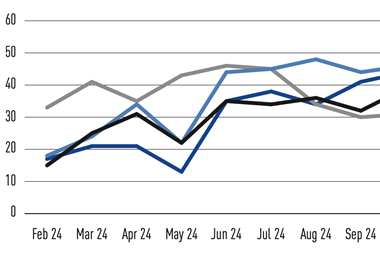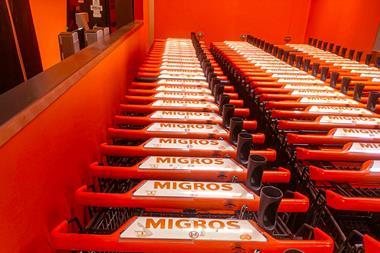Outside the window of Ton Groeneveld’s office in Utrecht, the trains run past constantly, a perpetual reminder if he ever needed it of what his job is all about. He is chief investment officer at SPF Beheer, the management company that was formed in 1994 to administer the e10bn Railways Pension Fund (Spoorwegpensioensfonds). “Before 1992, we were more or less a state pension fund, then we became privatised and following this, there was separation of the fund and the management.”
These were revolutionary steps indeed for a fund as venerable as this, which goes back long way, in fact to 1848, making it the oldest Dutch pension fund. Then in 2000, SPF Beheer took another important step of winning the mandate to administer the Public Transport Pension (Pensioenfonds Openbaar Vervoer) fund for those running the country’s buses, which resulted in another e1.7 bn under management for Groeneveld and his team.
When the fund was under the government’s wing, its investment ability was restricted to investing in the Netherlands, with just 25% in equities and real estate. “We were 75% in fixed income at that time,” he says. “So after the privatisation we became like a normal fund.”
This was about the time ALM was established in the Netherlands, which generally was giving the green light to more equity investing. “We also started investing abroad, first into other European countries, then the US and Japan under a five year plan.”
Another step was to increase the real estate share in the portfolio from about 5 to 10%. “As we were investing directly in Dutch property only, this was another exercise that took considerable time,” adds Groeneveld. “But nowadays we also have international real estate exposure indirectly.”
He and his team are advised on the investment side by the independent advisory committee, made up of four external, expert specialists, but operational decisions are made by an investment group, comprising the top level of the investment department, led by Groeneveld, and the heads of equities, fixed income, mortgage, real estate and of strategy. “We of course discuss quarterly our policies with the advisory committee and report regularly to the full boards of the two pension funds, formally also on a quarterly basis, but with a less detailed report monthly.”
“While there is much in common between the two funds in terms of policies and operations, the investment in terms of asset mix are different. Since the railways fund is much bigger, it has a wider diversification of assets across countries than the transport fund.” For example, the move into private equity is confined to the main fund currently.
The yearly ALM studies are handled in-house. The software is delivered by Ortec Consultants. “We ourselves do the number crunching and the review of the different scenarios. Our current assessment is that the very good times in terms of returns on equities in the 1990s has finished. But the problem from an ALM point of view is that we have used economic data from the past 20 or 25 years, but we cannot rely on these for the years ahead.”
So Groeneveld and his team recast the variables more realistically, looking first at fixed income returns at 5.5% and equity risk premiums at 3.5%, giving long term returns of 9% per annum from equities. “Calculated from January 2001 it is most probably too high for the coming years, but we are looking 20 years ahead.” This contrasts with the previous assumptions of perhaps 14 or 15% pa equity returns, he says. In the period from 1975 to 2000, the average equity returns were in the order of 15%. “Real estate is always the hardest to estimate, but from our own figures we think around 7% is reliable.” The private equity returns are estimated at 12% (with a standard deviation of 28%).
The ALM scenarios show that it is profitable to include real estate at 10% and that the part of equity investments in the asset mix could be in the range 40% to 60% equities. The attribution returns profile shows that the asset allocation decision can be responsible for over 50% of performance, with the regional/country mix and sector allocation accounting for about one fifth of returns each, with stock selection only contributing 5%. “These are indications rather than exact numbers,” he warns.
During this year, the weightings for equities were just over 50%, with a tactical range varying from 40 to 65%, fixed income at around 30% (17 to 43%), mortgages 5% (3to7%), real estate 10% (7.5 to 12.5%) and private equity 5% (0 to 7%).
The Railway Fund equity portfolio now has Euroland as its domestic market and it accounts for 50% of the allocation, with UK at 7%, US at 25% and Japan at 8%, with other markets at 10%. “We are active on the tactical side.” Five years ago, around 35% of the portfolio was managed passively and some shift to in-house active management was made then. “We wanted outperformance in relation to benchmarks, which meant active management.”
The remaining indexed portfolios were transitioned by Barclays Global Investors to enhanced portfolios, though there is still a small portion on a pure index tracking – this relates to the whole portfolio. “In addition, we do active management in-house through a structured process,” says Groeneveld. “This is done by underweighting or overweighting entire sectors or regions, as well as individual stocks. We do this by means of transactions, as we do not use futures at the moment. But we are looking at this question and will try to implement this in 2002.”
The first step in any tactical reallocation relates to over or underweighting stocks or fixed income. “The second step is reallocation within the equity and fixed income portfolios, and we actively buy and sell stocks to put this into effect.” The overall reallocation on asset mix level is done on a three-monthly basis, with the equity and fixed income portfolios being done more frequently. So after September 11, for example, the fund rotated its euro-portfolio to a more defensive stocks, and did the same in the US when the markets re-opened there. “We then diminished a large under weighting we had at that point in stocks in the tactical portfolio by 50%.”
Groeneveld believes the pendulum is swinging back from external to internal management among bigger Dutch pension funds. “When moving first to overseas investment, you have to acknowledge you do not have the skills to manage this in-house. That’s exactly what we did. But then we built up the skills enabling us to move to internal management again.”
Currently the fixed income portfolio is totally managed in-house for both government and credits and about more than 80% of the equity portfolio is looked after internally. “We reckon that external management is 10 to 20 times more expensive than internal management, though it depend on the type of management.” He is a firm believer in the advantages of the internal approach, adding: “It is not easy and it certainly keeps you modest. The target of the active management is out performance and certainly the Railways Pension Fund has no problems in meeting return objectives, with an annual average return of 14.3% per annum over the five years to 2000, compared with 12.3% for the WM universe of Dutch funds. Though 2000 itself turned in a 2% return meagre compared with the sparkling figures of the years before, with 17.2% in 1996, 19.7% in 1997,18.2% in 1998 and 15.3% in 1999. “Currently, we are experiencing a small underperformance for this year.”
The private equity is part of a five-year plan developed with consultants Cambridge Associates. “We expect our first investment in the next month or two. To start with we are taking the fund-of-funds route.” The aim is to build up gradually and later the Transport Fund may become involved too. “We have looked at hedge funds, but are not seriously pursuing this avenue at this moment.”
Mergers with other pension funds are not under active consideration currently, but this is something that has been looked at in the past, and that could come up again, Groeneveld acknowledges. But the management company SPF Beheer is always on the look-out for other funds to take under its wing as it has done with the Transport Fund. More assets under management enables more portfolio specialists to be employed and stabilises the organisation, he points out.
The portfolio is 80% hedged from a currency perspective, with the ability to go as low as 50% unhedged to 100% hedged. “Last year we started with an internal quantitative model for hedging we developed ourselves, and we started to become more active – with good results so far.”
Blue chips companies are more open to corporate governance issues now. The fund works with other leading funds such as ABP to improve this area.
And when it comes to socially responsible investing (SRI), the fund is building this into the investment process stage. Groeneveld declares: “It’s no good saying that 10% of the portfolio is SRI compliant while 90% is not – that’s just ridiculous.”












No comments yet